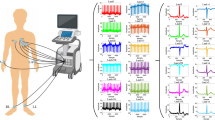Abstract.
Heart rate patterns may contain diagnostic as well as forensic information. To test these possibilities, individual heart rate patterns were represented as heart-rate cepstral vectors (HRCVs) computed in 12 dimensions via linear predictive coding (LPC) of brief segments of heart rate. A library of codebook vectors was computed for 12 cardiac patients from a standard ECG database. Statistical classification of subjects was based on the minimal weighted distances between test and codebook vectors. Weights were based on the ratio of inter- to intrasubject variances of their cepstral coefficients. Results showed that: (1) HRCV coefficients adequately reproduced the HRV spectrum, and (2) HRCV distances could be used to identify individuals within the group with a reliability of 93%. Thus, heart rate variations are an individual characteristic that can be represented as a single 12-dimensional vector.
Similar content being viewed by others
Author information
Authors and Affiliations
Additional information
Received: 16 December 1996 / Accepted in revised form: 7 May 1997
Rights and permissions
About this article
Cite this article
Curcie, D., Craelius, W. Recognition of individual heart rate patterns with cepstral vectors. Biol Cybern 77, 103–109 (1997). https://doi.org/10.1007/s004220050371
Issue Date:
DOI: https://doi.org/10.1007/s004220050371




